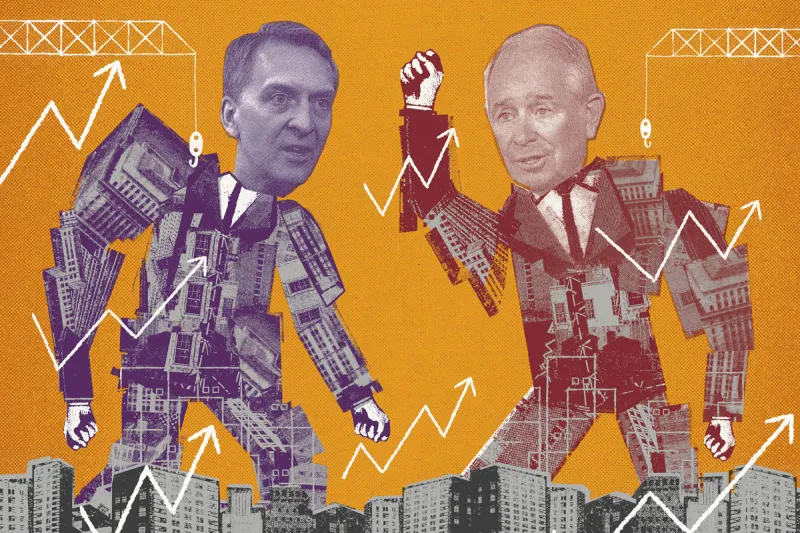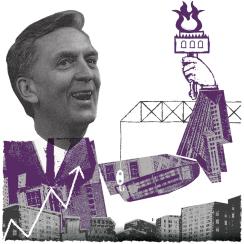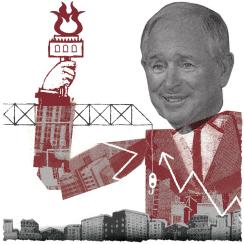
Bruce Flatt and Stephen Schwarzman.
(Illustrations by Ben Jones; photos via Bloomberg)
A generation ago power brokers from Washington and Wall Street mused that if reincarnation were possible, they would want to return as the bond market. In today’s low-interest-rate world, they almost certainly would choose to reincarnate as alternative-asset managers.
Preferably as Brookfield or Blackstone.
“Every traditional asset manager wants to get into alternatives,” boasts Brookfield Asset Management CEO Bruce Flatt in an exclusive interview with Institutional Investor.
Blackstone Group CEO Stephen Schwarzman doubts a second chance at life would make a difference. “This business requires skills beyond looking over research reports about stocks and bonds,” he tells II. “So what one hears is more desire than actuality.”
As institutional allocators continue to shift from stocks and bonds toward real assets with steadier, higher-interest returns, Blackstone and Brookfield have become the ranking — and increasingly rival — alternative players. Almost every month sees multibillion-dollar deals by the two behemoths unveiled: former maharaja palaces converted into luxury hotels by Brookfield; buy-and-leasebacks for the leading Las Vegas gambling resorts by Blackstone; wind farms in Europe for Blackstone and nuclear power servicing throughout the world for Brookfield.
Both firms are competing for lucrative infrastructure projects, a sector in which Brookfield is the clear leader. And in real estate, where Blackstone is currently dominant, the two are making big opposing wagers — with Blackstone embracing e-commerce and Brookfield pouring billions into upscale shopping malls.
Brookfield’s strong suit is operational. The manager is renowned for taking over an underperforming utility and restoring it to profitability, or building one from scratch with its own engineering and management teams. Blackstone, meanwhile, is unmatched in its private equity prowess, with an ability to sniff out business trends before competitors and score prolific returns for investors.
But there is something else that separates them: the growing importance of nationalism and political clout in the America First age. Blackstone’s Schwarzman behaves as if he has been delegated by his longtime friend President Donald Trump to be the American business community’s chief envoy to China or Saudi Arabia.
“One of my roles is to be alert to what is happening in the world,” says Schwarzman. Of course, aside from global fact-finding, those president-blessed missions abroad can lead to huge deals for Blackstone.
Such opportunities are unavailable to Brookfield, a Canadian corporation, and its Winnipeg, Manitoba–born CEO. Though half its business is in the U.S., Brookfield is forced to adopt a low profile. Indeed, many, if not most, U.S. lawmakers think the firm is American. “We act like locals in every country we’re in,” says Flatt.
But don’t shed tears for him. A thousand dollars invested in Brookfield 20 years ago are worth $34,000 today. Brookfield’s total assets have soared to $545 billion, are spread across 30 countries, and have attracted some 1,800 institutional investors. Blackstone still claims the top perch among alternative-asset managers, with $571 billion in assets under management — and, in contrast to its rival, with no debt.
Both powerhouses are set to maintain their torrid growth. A decade ago alternatives accounted for 5 percent of allocations at pension and sovereign funds. Today they make up almost a quarter, and Brookfield predicts that by 2030 more than half of allocations will shift into alternatives from other financial instruments held by sovereign and pension funds. By then alts could also claim double-digit-percent allocations at endowments and insurance companies. And the biggest prize of all awaits as private wealth follows suit.
Can’t-miss strategies always seem to draw too much capital, reduced returns, and sometimes disaster. And a few observers are already waving red flags. “I don’t see another deep downturn or financial crisis,” says Steven Kaplan, a private equity expert at the University of Chicago Booth School of Business. “But expected returns on everything are falling.”
Both Brookfield and Blackstone insist they are too large and too established to share the quotidian concerns of alternative newcomers.
According to Blackstone president and chief operating officer Jonathan Gray, his firm can count on the best available deals. “When you operate on a big scale, the number of competitors goes down,” he notes.
Brookfield is just as confident. “I don’t worry about too much money coming into the sector because the things we do give us a competitive advantage,” explains Flatt.
Perhaps nowhere is the advantage of “the things we do” better exemplified than in Flatt’s recent foray into India — and an intrafamilial drama that exposed charges of defamation, feuding brothers, and an $8 billion deal.
India is no exception.
Brookfield has maintained a finely tuned balance between courage and caution in India, born from its 121-year experience with emerging markets. Founded in 1899 to build tram and electricity lines in Brazil, it was known as Brascan — an allusion to its Brazilian operations and Canadian headquarters — until being renamed Brookfield in 2005 by Flatt.
Brookfield’s strategy is to invest in a country that has promising long-term economic prospects but is undergoing serious short-term disruption. The cheaper assets resulting from such disruption can be snatched up by deep-pocketed, experienced alt managers like Brookfield.
In terms of these criteria, says Flatt, India is “the No. 1 country in the world today.”
During the global financial crisis and its aftermath, India was a rare outpost of economic expansion. But more recently, growth has slowed and the nation has suffered financial stress that has left many companies in dire straits. The banking system is saddled with $130 billion in nonperforming loans, which at 10 percent of all loans means the highest NPL ratio among the world’s top-ten economies.
Brookfield has been in India since 2008, but did not sign a major deal there for six years. The firm thought valuations were too high during India’s boom period — so instead it went about building an operational platform that now employs 6,000 people and put them to work mainly servicing businesses that might someday become available at more reasonable prices. Only after Brookfield saw signs of capital dislocation did it make its first significant transaction, the purchase of a large commercial property owner in 2014.
Since then, Brookfield has amassed more than $17 billion in AUM in India, with investments in real estate, infrastructure, power, and private equity. Several of the biggest deals involved assets plucked cheaply from local banks whose corporate clients were close to defaulting. Brookfield acquired a luxury hotel group, five national highways, and the nation’s only cross-country gas pipeline, and has purchased the second-largest telecommunications tower portfolio in the world.
This last deal alone was worth $8 billion. To pull it off, Brookfield waded into India’s most notorious business family fight.
After the death in 2002 of Dhirubhai Ambani, his two sons — Mukesh and Anil — wrestled for control of his Reliance Industries, the richest private sector empire in the subcontinent. Unable to reconcile the sons, their mother, Kokilaben, split the family business in 2005, granting the larger part of Reliance to the eldest, Mukesh. Anil renamed his portion Reliance Group.
But the fraternal quarrel escalated into a Bollywood-worthy saga. The brothers denounced each other in the media at home and abroad. Anil accused Mukesh of colluding with senior government officials for lucrative contracts. Anil also filed a multibillion-dollar defamation suit against his brother. In the end, Mukesh emerged as India’s richest magnate, as Anil struggled under mounting debt to keep his business afloat.
That’s when Brookfield stepped in. It came close to purchasing part ownership of 40,000 telecom towers from Anil Ambani. But the deal foundered in 2017 owing to regulatory obstacles. “And we’re thankful it did,” says Anuj Ranjan, Brookfield managing partner and CEO for India and the Middle East.
Brookfield next turned its gaze to the older brother’s business. With market conditions deteriorating in India, even Mukesh Ambani was struggling and decided to sell assets for the first time. Early this year, Brookfield completed a buy-and-leaseback deal with Reliance Industries for 170,000 telecom towers — a network second only to that of China Tower.
And Brookfield hasn’t given up hope of acquiring the younger Ambani brother’s telecom tower portfolio. “We still might revisit that in the future,” says Ranjan.
Brookfield in India is the paragon of a traditional approach to alternative-asset management: a disciplined sizing up of a market, the buildup of a large operating team, and an expensive bet on an eventual economic upturn. So the Canadian company can only gnash its teeth at the shortcuts available elsewhere to rival Blackstone.
In May 2017, Schwarzman accompanied Trump to Riyadh — the president’s first trip abroad — and announced with great fanfare that Blackstone and Saudi Arabia would join to create the world’s largest infrastructure fund. Saudi Arabia’s sovereign wealth fund promised to match other investors and contribute half of the $40 billion total, which is earmarked for highways, bridges, power plants, and other infrastructure projects, mainly in the U.S.
The murder and dismemberment of U.S.-based Washington Post columnist Jamal Khashoggi, a fierce critic of Saudi Crown Prince Mohammed bin Salman’s regime, slowed the deal’s momentum. Scandalized by the butchery, institutional investors held back or agreed to put up money only after Blackstone offered discounts, according to documents made public by the Commonwealth of Pennsylvania’s Public School Employees’ Retirement System, among others.
But as outrage over the Khashoggi episode faded, investment in the infrastructure fund accelerated. By the end of 2019, $14 billion of capital — half of it Saudi money — was committed to the business. The two most notable infrastructure fund investments were $6.3 billion for full ownership of Tallgrass Energy, a midstream company operating pipelines in the U.S. Midwest, and a minority stake for an undisclosed amount in Carrix, a leading operator of ports along the U.S. West Coast and Mexico.
But that’s still far short of Blackstone’s goal, announced at the firm’s Investor Day in 2018, to overtake Brookfield and become the largest infrastructure business in the world. “There are others who have been at this longer than we have,” concedes Blackstone’s Gray.

Blackstone began to amass industrial real estate a decade ago, well before online shopping gathered steam. “I’d love to say we had perfect foresight,” says Gray. “But we started out as an accidental investor in e-commerce.” In the aftermath of the financial crisis, distressed properties flooded the market. With warehouse occupancy rates correlated with GDP growth, Blackstone bought the real estate in anticipation of an eventual economic upturn.
But it soon noticed that industrial property prices and rentals were rising a lot faster than GDP. And in most cases, the tenants were either e-commerce merchants or businesses renting space to them. “A light bulb went on,” says Gray, who was head of global real estate at the time. Blackstone accelerated its industrial real estate purchases in the U.S. and abroad.
Besides scouting out sites well ahead of competitors, Blackstone had the financial clout to close all-cash deals for huge blocs of property. Last year, in a record industrial real estate deal, Blackstone spent $18.7 billion to acquire warehouses across the U.S. from Singapore-based GLP. The deal came just as a same-day delivery war erupted among Amazon, Walmart, Target, and other e-commerce rivals. Owners of warehouses and fulfillment centers linked to e-commerce saw their REIT shares soar by almost 50 percent in 2019.
[II Deep Dive: It Dominates Everything It Touches. But Can Amazon Compete With . . . Walmart?]
But among the worst performers were REIT shares linked to shopping malls — a sector in which Brookfield is the second-largest player. Between 2016 and 2018, the manager acquired a portfolio of commercial properties — mainly shopping malls — known as GGP, with a market value of more than $15 billion.
Although the business plummeted in value with the advent of e-commerce, Brookfield insists that upscale malls can still thrive. It plans to use its operational teams to enhance the value of the properties by building more upscale commercial and residential space on the same land. Still, with major mall tenants like Sears and Forever 21 filing for bankruptcy protection and others like Macy’s and JCPenney shuttering more than 100 stores combined, Brookfield’s wager seems like a long shot.
“That’s exactly what we look for as contrarian investors — something that is universally out of favor,” says Brian Kingston, the CEO of Brookfield Property Group. It’s not mere bravado. His office rises above the 9/11 acreage that Brookfield transformed into a swank shopping and business complex, even though few investors believed the lower Manhattan neighborhood could recover from the 2001 terrorist attack.
Although the GGP portfolio doesn’t carry the same emotional legacy, it is a far larger undertaking. Its 125 malls — out of a total of about 1,100 in the U.S. — occupy the equivalent of 16 square miles. And the acquisition and management of the portfolio offer insights into how Brookfield Asset Management, the parent company, operates in tandem with its listed partners, in this case Brookfield Property Partners (BPY).
BPY, which is 51 percent owned by BAM, purchased the mall portfolio. Besides collecting dividends commensurate with its stake, BAM receives a base management fee, plus a performance fee if dividends rise above a certain level.
Investors can choose between buying into BAM, with exposure to all of the parent company’s holdings, or putting their money into a listed partnership more focused on a single business sector — real estate, in the case of BPY. Because BAM doesn’t pay much of a dividend, a listed partnership appeals more to yield investors.
But BPY’s share price rose only 7 percent last year, compared with a 46 percent increase for the parent company. And blame for BPY’s lag rests squarely on the low esteem for malls among investors. Shopping centers are divided between A malls, located in densely populated urban zones with high land value, and B malls, in more sparsely populated areas with low land values.
Most of the malls owned by BPY are in the A category. The listed partnership’s strategy is to focus on high-end commercial tenants and use Brookfield’s operational expertise to convert parking lots into office and luxury apartment high-rises. An example is the Ala Moana shopping center in Honolulu, where BPY developed 250 condos at the mall. “We sold them off and made a lot of money,” notes Kingston.
But investors tend to focus on the 35 lower-tier B malls in BPY’s portfolio, which aren’t so easily transformed. “The strategy for the top part of the portfolio makes a ton of sense,” says Vince Tibone, an analyst at Green Street Advisors, a leading real estate research firm. “The bottom tier, though, is going to be a challenge — no question.”
Even the most promising B malls — like a shopping center in Newark, California, a 40-minute train ride from San Francisco — will take up to five years to redevelop. “And the public markets don’t tend to think five years in advance,” says Kingston.

Because of its history in private equity, Blackstone rarely uses its balance sheet for growth. It relies instead on investments by limited partners drawn to its brand and track record. Shareholders are paid out of Blackstone’s earnings in dividends and buybacks. Meanwhile, the balance sheet has remained almost flat even though the company’s asset base grows by more than 20 percent a year.
Whenever possible, Blackstone prefers acquisition targets that mirror its capital-light strategy. The poster child is Hilton Worldwide Holdings, its most lucrative investment. Blackstone acquired the hotel chain operator in 2007, on the eve of the financial crisis, and sold it 11 years later at a whopping $14 billion profit.
Hilton doesn’t own or build hotels. Instead, leveraging its brand and using a minimum of capital, it signs long-term franchise and management contracts. “That’s our kind of model,” says Gray, who still serves as chairman of Hilton Worldwide.
In contrast, Brookfield’s balance-sheet approach to investing draws heavily on the firm’s own past. Two decades ago, Brookfield was a publicly listed conglomerate that owned and operated asset subsidiaries. In the early 2000s it transitioned into Brookfield Asset Management and spun off the subsidiaries once held on its balance sheet into four publicly listed partnerships. At the same time, it invited pensions, sovereign funds, endowments, and other institutions to invest alongside BAM and its listed partnerships through private funds.
At times, investors seem befuddled by the multiple investment options and are left to wonder if the parent firm and its LPs are chasing the same deals. Flatt is often asked about the relative merits of investing in BAM versus its LPs. “They are just different vehicles created for different groups of investors,” he replies.
Another source of investor annoyance is Brookfield’s use of funds from operations to report earnings — instead of the usual metric of distributable earnings, adopted by Blackstone and other asset managers. FFO is a legacy from the years when Brookfield was more of a conglomerate than an asset manager. “It’s confusing,” says Robert Lee, an analyst at investment bank Keefe, Bruyette & Woods.
BAM continues to depend heavily on its balance sheet to aid its LPs. Thus it is the biggest shareholder in all four of the LPs and often is the largest single contributor to their new funds.
According to Flatt, there is no better way of demonstrating Brookfield’s alignment with shareholders in BAM and its LPs. “We eat our own cooking,” he told shareholders on Investor Day last September. (Blackstone cites the $7 billion in personal investments by its employees in the company’s funds as sufficient evidence of alignment with outside investors.)
BAM sometimes uses its balance sheet to make transformative acquisitions on its own. The most recent was a $4.8 billion deal last year for 61.2 percent of Oaktree Capital Management, a distressed-debt investor with $120 billion in AUM. Oaktree fills a major gap in Brookfield’s financial arsenal — the ability to invest in debt and raise capital during a recession. “At some point we will have less robust times, and their franchise excels at liquid credit during those periods,” notes Flatt.
Blackstone has a less complicated structure and offers more-straightforward financial reporting than Brookfield. But for years it faced grumbling from shareholders over its status as a listed partnership. For tax reasons, Blackstone resisted converting to a C-corp as most of its peers had done. But this prevented investing by passive money managers — like mutual funds — with mandates against purchasing shares in listed partnerships.
“We inadvertently punished ourselves because only one third of potential investors were able to buy our stock,” explains Schwarzman.
Then came Trump’s 2018 reduction of the corporate tax rate, from 35 percent to 21 percent. Blackstone made the leap to C-corp, and its share price almost doubled in 2019 as a bigger pool of investors became eligible to buy its stock.
In recent years the alt world — led by Brookfield and Blackstone — has focused on generating fees from assets and holding on to those assets longer. Capital is locked up for a decade or more. Fees pile up to the benefit of asset manager and shareholders. And investors benefit from more-visible, predictable cash flows.
Brookfield has pursued a stable cash flow strategy longer than any alt. About 75 percent of its fee-bearing capital is either in permanent capital or unredeemable until the end of a fund’s life.
Parent company BAM charges its listed partnerships a 1.25 percent management fee, plus performance fees of 15 to 25 percent. BAM’s cash flow is evenly split between fee-related earnings and distributions from the four LPs. Net income last year was $5.4 billion.
Blackstone charges a 1.25 to 2 percent management fee and a 20 percent performance fee after 8 percent of invested capital is returned to its limited partners. Last year fee-related earnings accounted for well over half of distributable earnings. Net income was $3.9 billion.
A decade ago, Blackstone was still pursuing the time-proven private equity formula — buy-fix-sell — typically holding on to an acquisition for five years before unloading it. More recent acquisitions have timelines of anywhere from a decade to indefinite, for perpetual vehicles. The most prominent example of the latter was a $5.3 billion deal with New York City in 2015 for Stuyvesant Town, the 80-acre Manhattan development that is home to 30,000 mainly middle-class residential renters. “We can own it indefinitely,” says Blackstone chief financial officer Michael Chae. “We have no plans to sell, nor do we have to.”
Brookfield, ever the engineer, points to infrastructure needs that can no longer be met by governments and that will require $50 trillion of mostly private capital over the next several decades.
Blackstone, with its strong private equity bias, looks to a potential $30 trillion in private wealth sources, ranging from billionaire family offices to Main Street savings accounts. “Why should only wealthy people get to benefit from superior performance in alternatives?” asks Schwarzman. “There is no reason why regular people should be disadvantaged.”
Little wonder that traditional money managers are trying to crash the alt party. At one end, Goldman Sachs is pushing its upscale clients to broaden their portfolios with more alternative investments. At the other end, BlackRock and Vanguard — better known for low-cost stock-and-bond funds aimed at middle-class households — are launching private equity funds targeting institutional investors and high-wealth clients. Others are also eager to grow in the alt space. “It’s a priority,” says Judy Marlinski, president of Fidelity Institutional Asset Management.
“It won’t be easy for the new entrants,” warns Schwarzman.
Inevitably, at some point there will be too much money chasing some form of alternatives and mistakes will be made. More than half of alternative-asset managers were wiped out in 2008.
“But whoever made it through the financial crisis and kept their reputation intact — that’s where the money went,” says Flatt.
For the rest there’s always hope for another shot at reincarnation.





